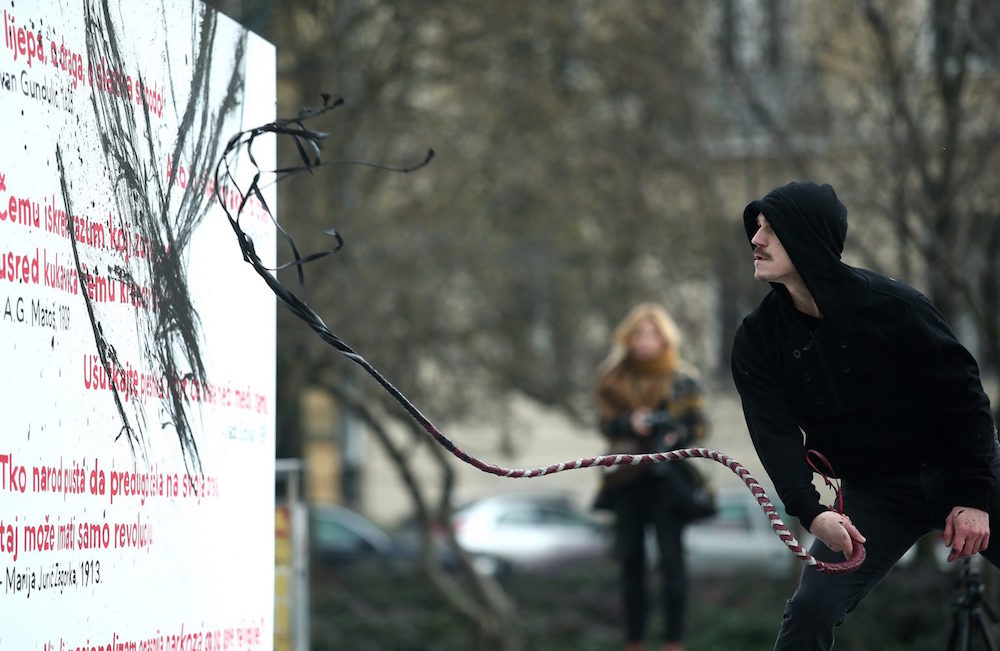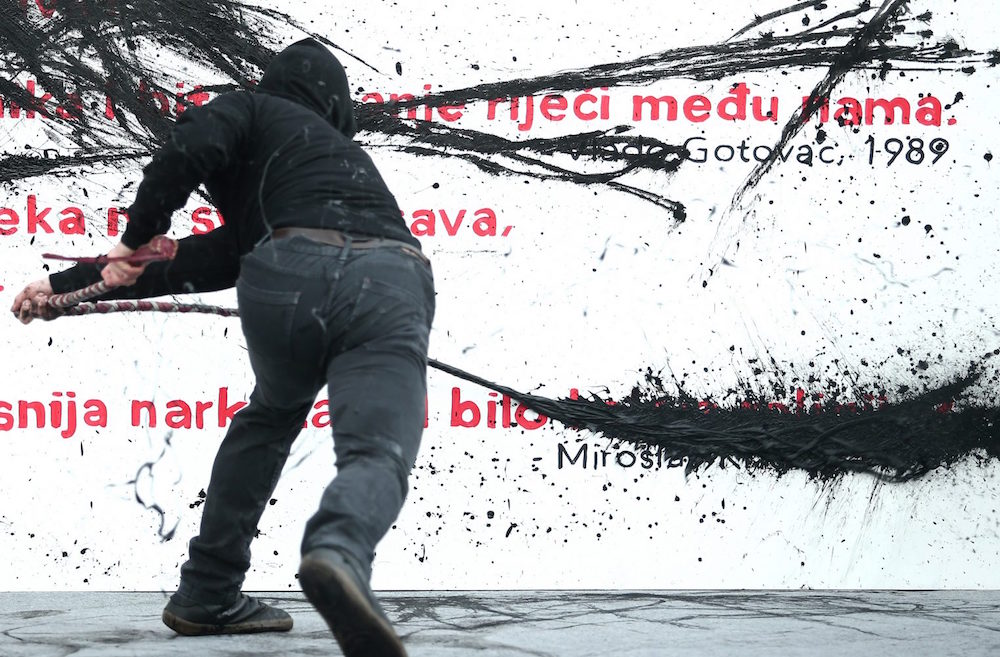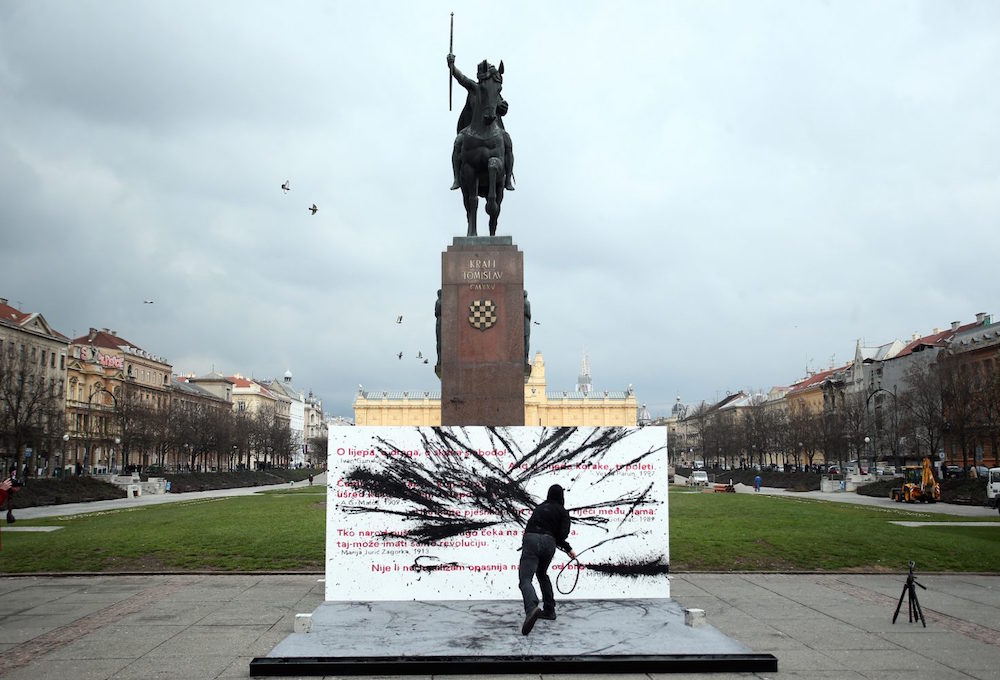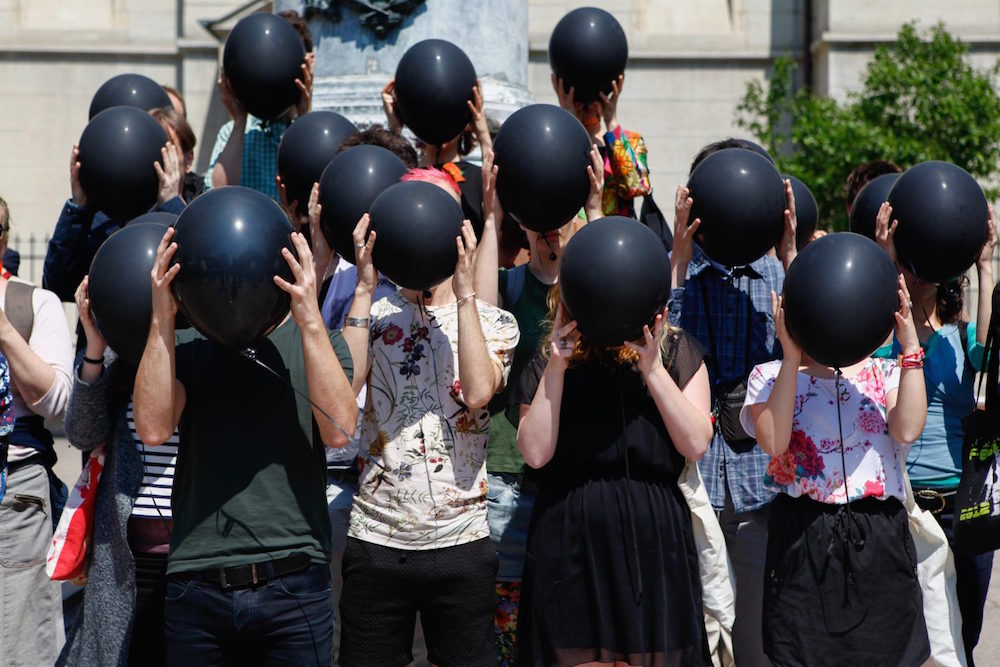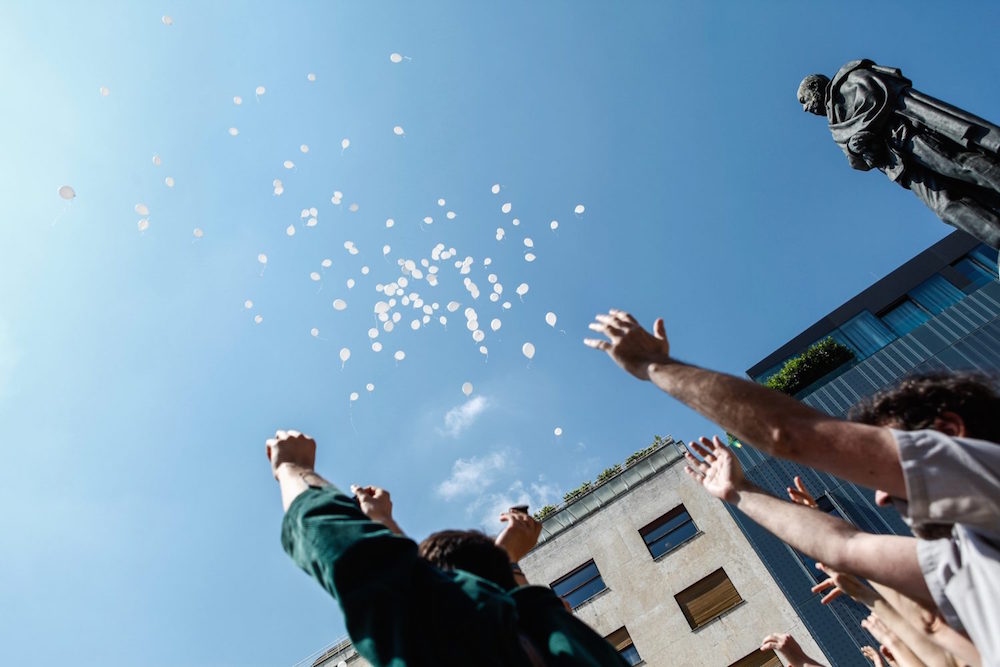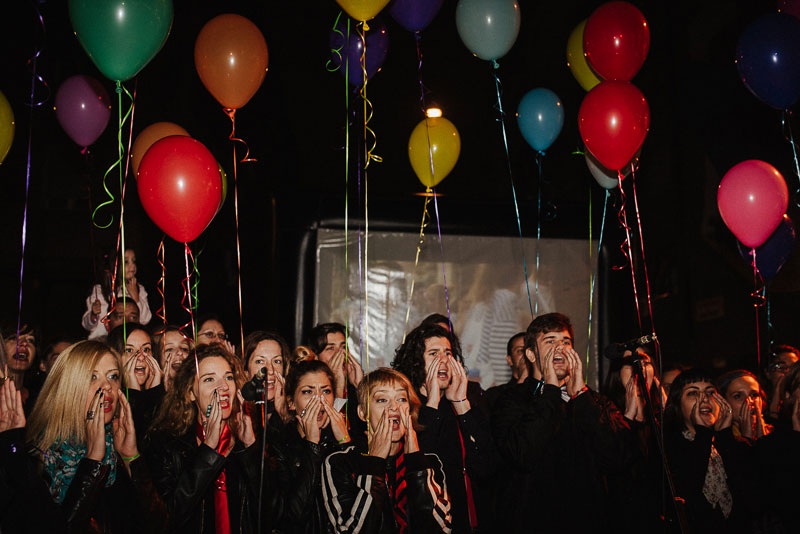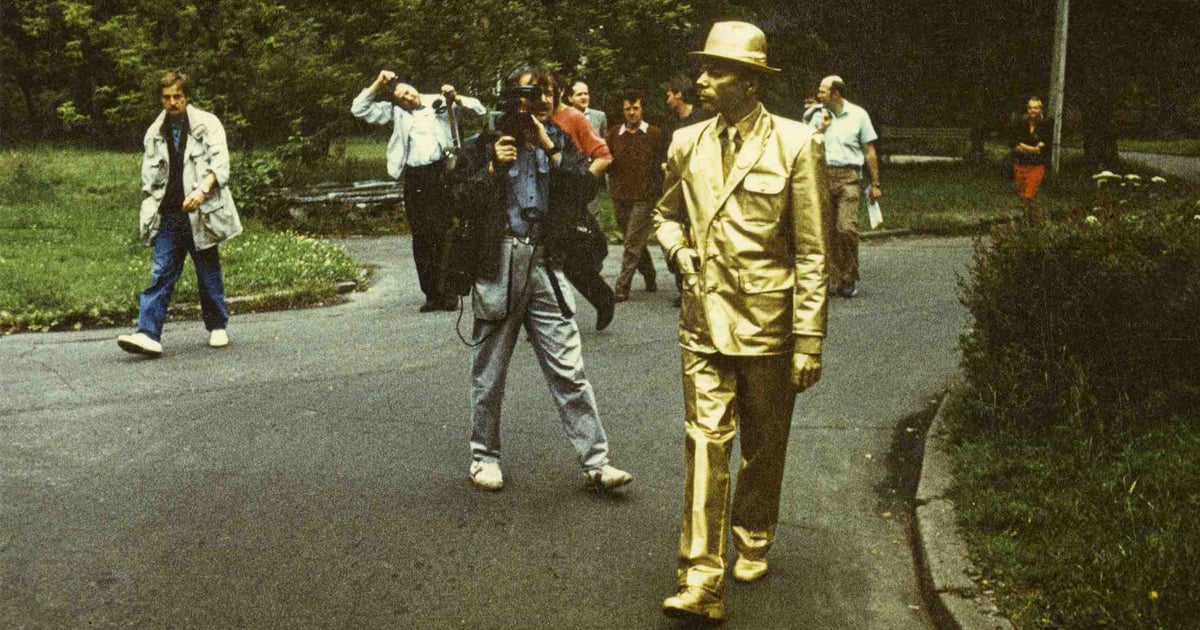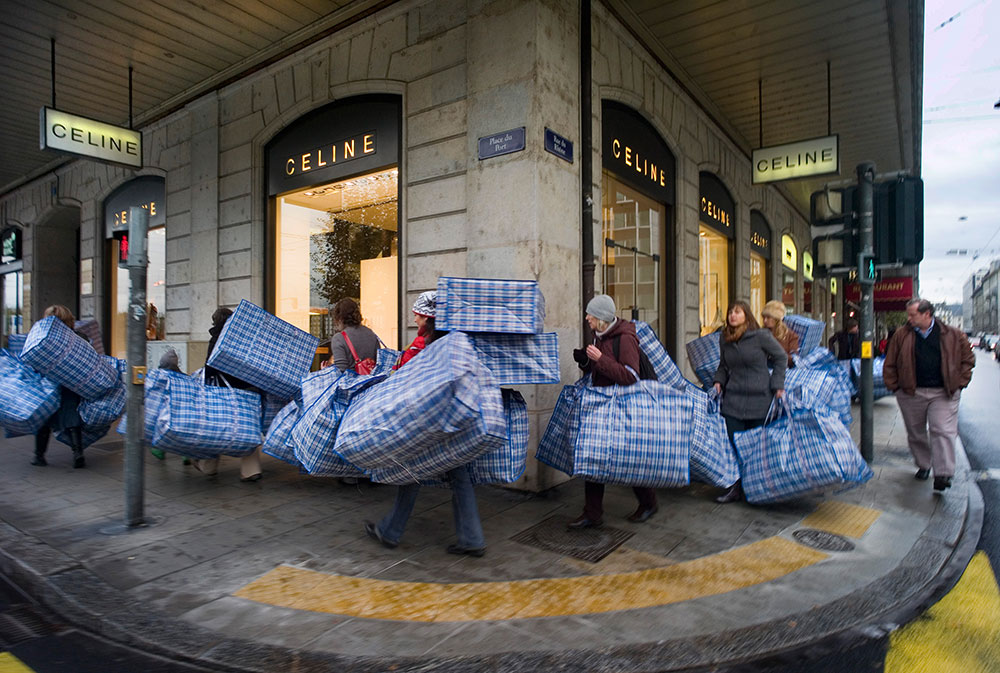Performing the political: the Croatian artists staging public resistance to injustice
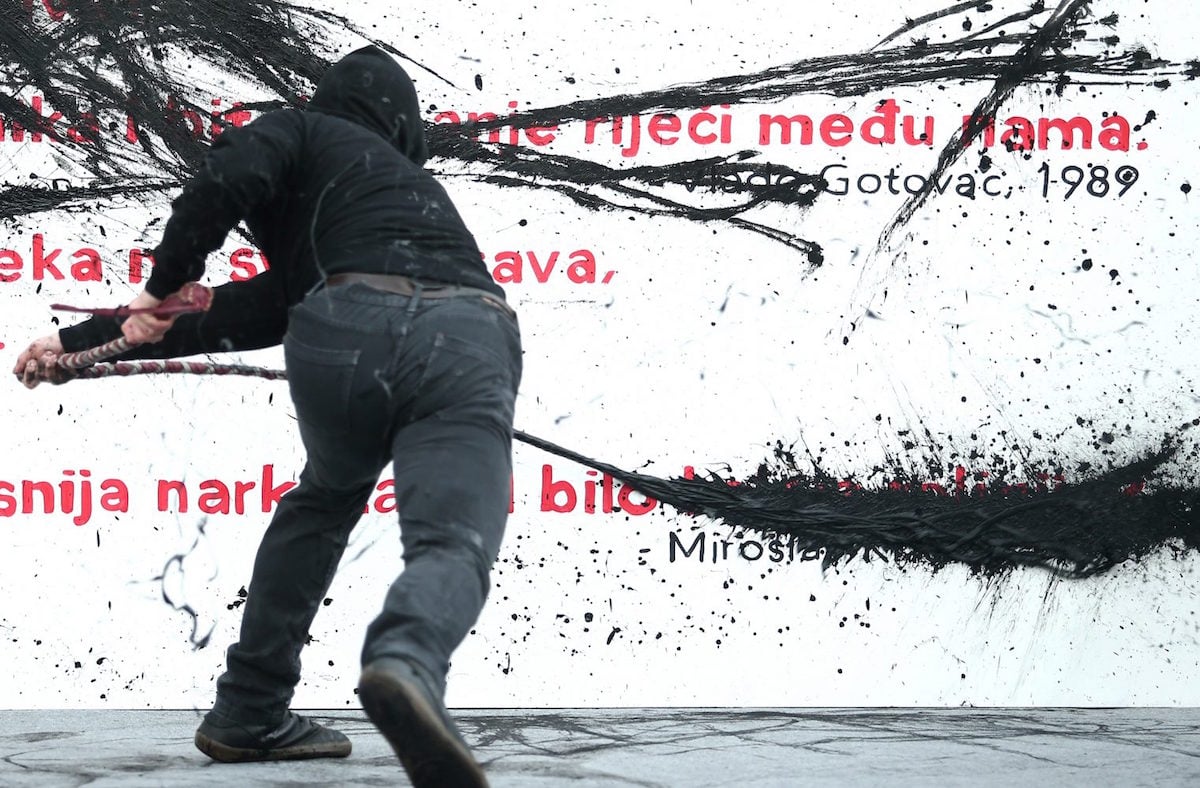
In response to successive right-wing governments and Culture Ministers, Croatian performance artists are taking to the streets. Jelena Prtoric explores a world of pirate radio, public whipping and anti-fascist resistance
Those leaving the central railway station in the Croatian capital Zagreb at around noon on 20 February 2016 would have stumbled upon a crowd fixated on a man in a black hoody, with a long rope in his hands. After dipping the rope in black paint, the man proceeded to flagellate a white canvas in front of him. The canvas — soon to be covered in black paint — featured several quotations from prominent Croatian authors. The first line, “Oh beautiful, oh dear, oh sweet freedom!” came from the most famous verse of the Baroque writer Ivan Gundulić’s poem, known to Croatians as the “Plea for Freedom”.
So what does make a man whip a national masterpiece in public? Politics. As Bruno Isaković, dancer, performer and the man behind the whip explains: “the attacks on freedom of the press, on the artistic freedom, that took place at the time. I wanted to provoke, to publicly denounce cultural politics, so I thought the best way to do it was to use quotations from great Croatian authors who fought for freedom, who wrote about freedom, and to annihilate their words, to show metaphorically what was being done in Croatian cultural politics.”
The trigger for Isaković’s artistic engagement was the appointment of Zlatko Hasanbegović as Culture Minister for the right-wing government that came to power in January 2016. Conservative and zealously patriotic, Hasanbegović had since the beginning of his mandate been criticised for his lack of experience in culture management, his historical revisionism and his moves to curb media freedom. His first move as minister was to dismiss the council for non-profit media, and therefore largely eliminate their funding.
“He motivated me to get political in my performances”, claims Isaković, whose previous work focused more on the body. The flagellation was only the first part of a performance series named for that Gundulić line: Oh beautiful, oh dear, oh sweet freedom! The second performance saw Isaković reading one of Hasanbegović’s books out loud in a museum lobby, while being subjected to Chinese water torture, water slowly dripping onto his forehead over four hours. The third featured a choir that silently stood through the composition Anthem to Freedom by Croatian composer Jakov Gotovac as it played in one of Zagreb’s main squares.
Isaković is part of a larger artistic trend towards resistance in Croatia. The importance and continued relevance of socially-engaged political performance has to be viewed within the Croatian historical context: from the breakup of Yugoslavia, followed by a bloody war, through transition process(es) that were left unfinished before the economic crisis arrived. Each of these landmark events inspired various artists to deliver their own political and performative comment. And Hasanbegović’s appointment to the crucial position of Minister of Culture, made political performance great again.
Formed in response, the Kulturnjaci 2016 initiative gathered together a large number of cultural professionals to organise a number of public interventions. In April 2016, they covered central Zagreb’s “Grounded Sun” statue in black cloth. A couple of weeks later, they organised public readings of Umberto Eco’s essay “Ur Fascism”, criticising the symbolic violence of the state, and its discourses of intolerance and exclusion.
Conservative and zealously patriotic, Hasanbegović had since the beginning of his mandate been criticised for his lack of experience in culture management, his historical revisionism and his moves to curb media freedom
When award-winning radio journalist Ljubica Letinić woke up in July 2016 to find that two of her publically-broadcast radio shows had been cancelled, the Kulturnjaci, along with some other platforms, organised a protest action in the form of a radio show. On one of Zagreb’s squares choirs sang live, a radio play was performed and round table interviews took place. “We managed to broadcast “live radio” from the street! It was a form of a protest action, it had a strong performative value, and really good, engaging content,” Letinić tells me.
However, since the government’s measures affected mostly culture and media professionals, these performances didn’t always find their way to broader audiences. One artist who has managed to propel performance art from minority to larger audiences, skilfully combining excellent satire with broader relevance and relatability, is Siniša Labrović, who has been addressing Croatian social, economic and political issues since 2000.
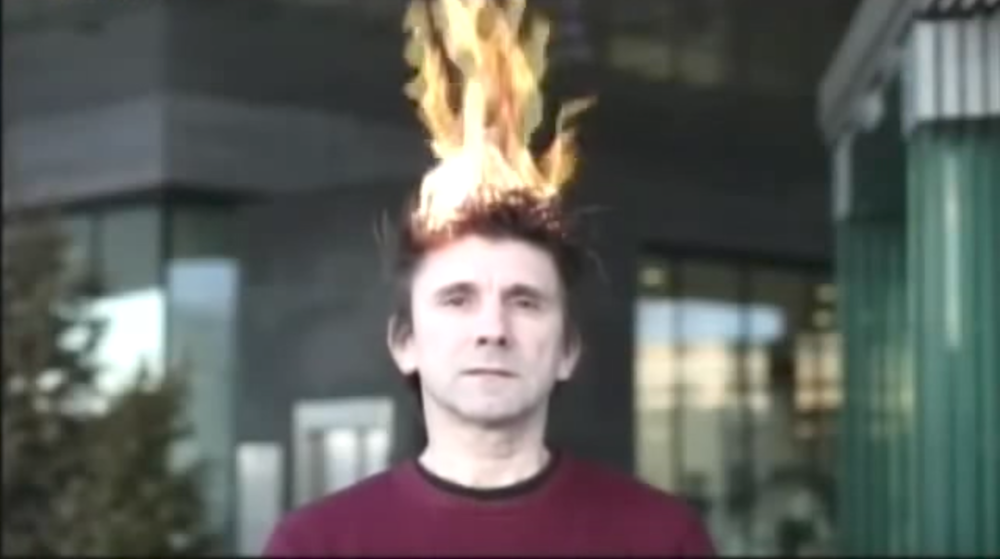
“To say that every art is political is somewhat a commonplace. At the same time, it is kind of true. Today, no matter how one’s society is organised, one cannot escape that political dimension of everyday life”, Labrović reasons. “From the ‘90s on, we, as a nation, have learnt in a very traumatic way the importance of politics and of being political. Until the age of 25, I lived under socialism, five years of brutal war followed, and ever since we have been living in a so-called democracy. Maybe this isn’t much from a historical perspective, but for one man, it is a lot.”
He started his performance career back in 2000, with the help of some plasters. In his hometown Sinj, he decided to “bandage the wounds” of a statue of a partisan woman holding a wounded soldier, which had been damaged by nationalists. The action took place on Anti-Fascist Resistance Day, linking past and future struggles for freedom in Croatia together.
Ever since, Labrović has admonished and provoked the corrupt, intolerant and aggressive, but especially those in power. In 2008, he held a performance in the town square to demonstrate (ironic) support for then-Prime Minister Ivo Sanader — later accused of corruption and embezzlement. He also organised a pilgrimage on behalf of the mayor of Zagreb (also accused of corruption on several occasions) after the latter granted dodgy cultural subventions in 2012. He also challenged a former Culture Minister to a boxing match (below); the winner would have assumed the ministerial title.
“I do let my anger to lead me”, says Labrović. “I feel this immense injustice, because so many lives were lost during the war, people’s lives were reduced to pure survival. And others got rich in the meantime. I’m motivated by the idea that my actions represent a space to defend differences in a society that tries to fit us into moulds. I have heard that some of the people targeted in my performances were affected by them, that they felt hurt. I don’t mind, I think it’s fair.”
Labrović didn’t get a chance to challenge Hasanbegović to a boxing match: that government fell after only six months in power — over a corruption scandal. A year later, though, with a new conservative government in power, little has changed. Hasanbegović might not be Culture Minister anymore, but the measures he implemented haven’t been annulled. The culture sector and independent media still denounce the rise of nationalism, historical revisionism and conservatism.
“I feel this immense injustice, because so many lives were lost during the war, people’s lives were reduced to pure survival. And others got rich in the meantime.”
Letinić has never managed to get her two radio shows back on air. In order to do the kind of radio that can’t be heard in Croatia anymore, she came up with the idea of “radio performances”, or “guerrilla radio projects”. She organised one in Zagreb at the beginning of June, broadcasting on issues of women’s rights, pro-choice movements and women partisan poets. “In Croatia in 2017, these are all unsettling topics,”, she says: an allusion to the fact that the nation’s partisan, anti-fascist heritage has been shunned by the same conservative governments who have also attacked reproductive rights
Again, a link is drawn to resistances of the past. “We put an antenna on a rooftop, and did one-day radio show. This is maybe how we could do it in the future, we could start broadcasting pirate radio shows. Set the day and the time, once per week, and broadcast for an hour. Along the lines of what was done in World War Two”, she declares.
As for Labrović, he says that too much political commentary can wear one out. “Maybe I am saying this in a moment of resignation, of fatigue, but what motivates me right now, what I would like to dedicate myself to this next year, is to find a way to leave this country. I wouldn’t necessarily be pursuing my art “career,” but I wouldn’t feel constantly humiliated. It would mean the possibility to live in dignity. Personal and social dignity.” In such conditions, an artist would no longer need to be angry.
